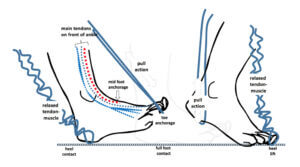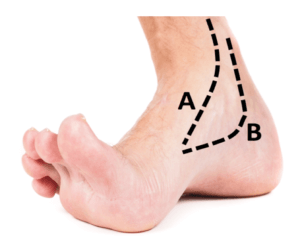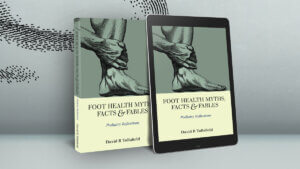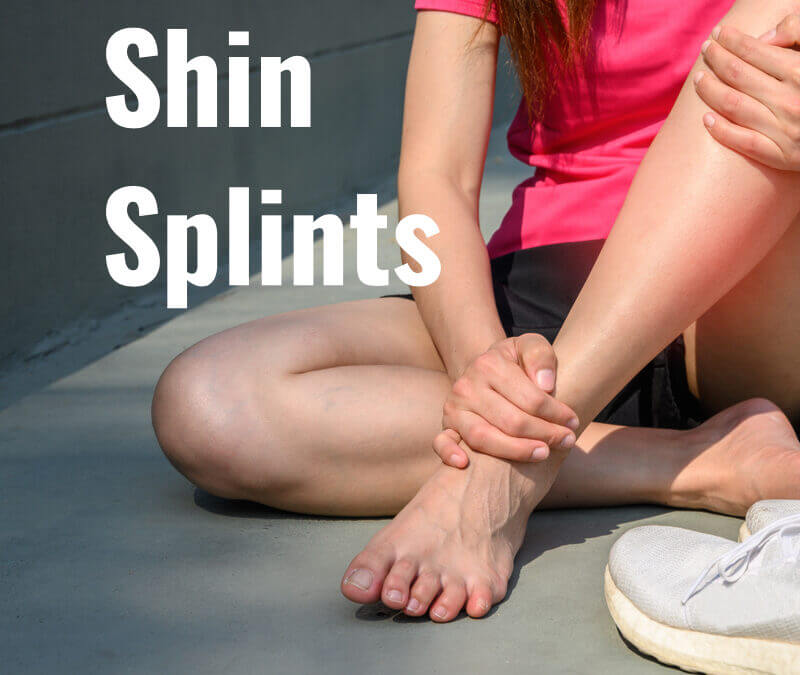Mechanics of shins splints and tendon dysfunction
What does this article intend to cover?
This is a self-help article to assist with the common problem of shin splints and tendon dysfunction. Muscles and their tendons often become overactive. The featured image shows a woman rubbing her ankle and lower leg, but shin splints develop higher than this and take its name from the shin bone. The reason for many tendon problems originates from the need to actively slow movement down. This is called deceleration and the tendons are as active in this mode as they are when they are trying to speed movement (accelerate).
This article on the mechanics of shin splints and tendon dysfunction will hope to:
- Describe the walking cycle
- Explain what shin splints are
- Provide information to help your condition
The Gait Cycle
This is made up of the stance phase and swing phase. When one foot is on the ground, the other is moving through the air. At one point both feet are on the ground. When walking there is no point when both feet are off the ground. This latter situation only arises when running. This article concentrates on walking. Please review this stick diagram film to help understand the gait cycle. It is short, there is no voice-over and it covers the basics.
STANCE PHASE

Heel contact and loading response.(From Perry J: Normal and pathologic gait, in Atlas of Orthotics, ed 2. St Louis, Mosby-Year Book, 1985, p 77.
There are three parts to the stance phase which coincides with contact on the ground. Up until this point one foot is swinging in the air and the other foot is going through a heel contact – flat foot – heel lift. The time that contact takes is anything from 0.65 – 0.75 of a second. It is very fast. The foot should be balanced so that it does not roll in too much. This is called Pronation when the foot flattens out. The picture of the two feet can be viewed separately (see link in blue below).
 On the left side of the diagram, the front (anterior) tendons allow the toes to come to rest on the ground. The heel has contacted the ground but the toes are still coming down to the ground. Until the front of the foot has fully landed, the tendons won’t relax. On the right-sided diagram below, the heel lifts and the front tendons relaxed while the tendons at the back of the foot are active and tightened.
On the left side of the diagram, the front (anterior) tendons allow the toes to come to rest on the ground. The heel has contacted the ground but the toes are still coming down to the ground. Until the front of the foot has fully landed, the tendons won’t relax. On the right-sided diagram below, the heel lifts and the front tendons relaxed while the tendons at the back of the foot are active and tightened.
Click to download the larger picture of push-pull of tendons. When the tendons have to overwork to recover an unstable foot position they become inflamed along the lining. This inflammation is not only painful on movement but can burn or send sharp pains along the tendon
SWING PHASE
The opposite leg moves forwards swinging through the air (not shown) and is called swing phase. This has a pre-swing – mid-swing and terminal swing. The ankle tendons are held tighter until the foot lands fully. When the foot is in the air, without any ground contact, the ankle tendons turn the foot so the arch is higher and toes are kept catching the ground. This is known as supination.
Deceleration and acceleration
Once the heel contacts the ground, the tendons reverse their function and tighten creating a slowing down of the foot or decelerating the movement. This is represented by a pulling action. When the heel starts to lift with pull action, the front tendons relax. The walking cycle is repetitive and follows the above sequences. Swing-contact-swing etc…
As the heel contacts the ground, the tendons are still trying to allow the toes to return back down slowly without slamming the ground. Slamming the ground can cause shock forces to injure joints and even set up stress tears (microfractures). In some groups, newbie runners and fast-paced walkers, the changes in tendon-muscle function cause the overuse syndrome we know as shin splints.
Shin Splints
We had better simplify this wordy title of shin splints and tendon dysfunction. An alternative name is teno-synovitis or tendinitis. The term shin splints come from a condition that causes pain along the front of the leg bone or shin not just around the ankle. The shin has little fat and the skin is thin. When the discomfort is in front of the ankle, this is called anterior shin splints. However there is a condition of posterior shin splints, and this is behind the ankle. This condition can become wrapped up with another condition called posterior tibial tendon dysfunction or tendinitis (PTTD) and flatfoot.
We know a good deal about how muscles work because research studies have measured the electrical activity of their fibres. I have not included the Achilles tendon but this can become involved and a common reason for ankle pain. Matthew Solan, an orthopaedic surgeon provides a useful short video (2.53) clip here. This is a nice clearly presented piece of information.

FIGURE 2. A = Anterior tendon B = Posterior tendon of the ankle
Symptoms
Symptoms cause burning pain and touching and pressing along the shin is extremely tender. A remedy is recommended below to aid the problem. Tendon dysfunction relates to these big ankle tendons A&B front and back not working so well.
Anterior Shin splints (tenosynovitis)
There are three main tendons that cross the front of the ankle. The most common condition is tendon overuse of the anterior tendon (A). Because the tendons attach to muscle and muscle attaches to bone, the bone lining is irritated. The irritation and inflammation related to the fibres connecting the tissues which become strained. Fast walkers and runners are renowned for the condition. Both conditions are treatable by first aid. When the conditions become chronic then this is the time to seek help
Posterior Tibial Tendon Dysfunction (PTTD)
There is a close relationship between the tendons on the front of the leg and the tendon behind the ankle. This tendon is also called the poster tibial (PT) tendon after the leg bone. This tendon is a major player and categorising it falls to not just the ankle, but to the arch and the midfoot. We see the PT tendon involved with flat foot. Pain arising from the tendon also occurs due to overuse. These foot and leg tendons have an active function in moving joints and well as slowing action down (deceleration). Both tendons, A&B prevent overpronation.
Information to help your condition

Start by adjusting your activity programme
- Reduce activity by a ¼- ½ unless the pain is intense still. Then rest for 2
- Walking: reduce the stride length and speed. 5.5kph is moderately fast. +6 will take you to jogging. 3kph is better. Also reduce incline down on treadmills or adjust terrain to flatter surfaces.
- Running: adjust the surface, ensure it is softer or change the direction of the run.
- Keep an activity in the gym to the cross-trainer or bike rather than the treadmill.
Direct action
- Massage the shin to help with softening, reducing pain.
- Make sure shoes/boots are not heavy. If yes, select lighter design.
- Ice down the shin 2-3 times a day.
- Tip: put a lolly stick into ice to prevent fingers from freezing.
- Use anti-inflammatory gels or deep heat creams.
- Don’t use oral anti-inflammatories unless pain is above scale 3 and at rest.
- Use an inexpensive orthosis. As long as it is not soft and flattens out and has an arch raise and heel cup, use these as much as you can to reduce the shock up the tendons.
- Taping the shin can be helpful and I have included a link using kinesiology [click for applying tape]
- A compression sock might be helpful as it supports the front shin muscles. Internet suppliers have a wide range.
- Active exercises to strengthen the tendons on the front of the ankle with a Thera band approach are reasonable but only once the main symptoms have quietened down. Maintain a good stretch on the Achilles tendon to maintain good core balancing.
- Return to activity once the main discomfort has reduced. Keep up all your methods to reduce pain and inflammation until you can start the activity without discomfort.
- RICE is important and follows the usual lines of decreasing activity, using ice to calm the tendon and inflammation, and dealing with pain with gels and heat. Heat and cold can be used but separately. Ice for swelling and immediate pain, heat for later after the immediate pain phases.
- Support with ankle compression and taping. There are a number of methods but I will reserve the figure 8 bandage again for this problem as you can reverse where you start. (Video)
- Supportive foot-ankle-leg splints are available as they are for ankles, but the strength of their support lies on the inner side of the ankle, not outside. https://www.healthandcare.co.uk/blog/best-posterior-tibial-tendonitis-brace-2019.html. There are a number of brands on the market.
- An arch support type inlay is valuable if tolerated.
- Footwear with good ankle support is essential.
Summary
By recognising shin splints early you can reduce the problem before it becomes chronic. Shin splints affect the foot and ankle above the along the shin bone. Confusion with posterior tibial tendon problems needs to be isolated. Understand that walking both problem of shin splints and PTTD so changing your pattern of activity can help. Local self help without medication is better. Remember medication does not cure the problem.
You can read more articles on ankles and ankle pain here on ConsultingFootPain. Why not sign-up to receive newsfeed updates
Thanks for reading this article “Shin splints and tendon dysfunction” by David R Tollafield
Sign-up for here my regular FREE newsfeed
Why not read Foot Health Myths Facts & Fables available from Amazon books

Published by Busypencilcase Communications Est. 2015 for ConsultingFootPain



Recent Comments